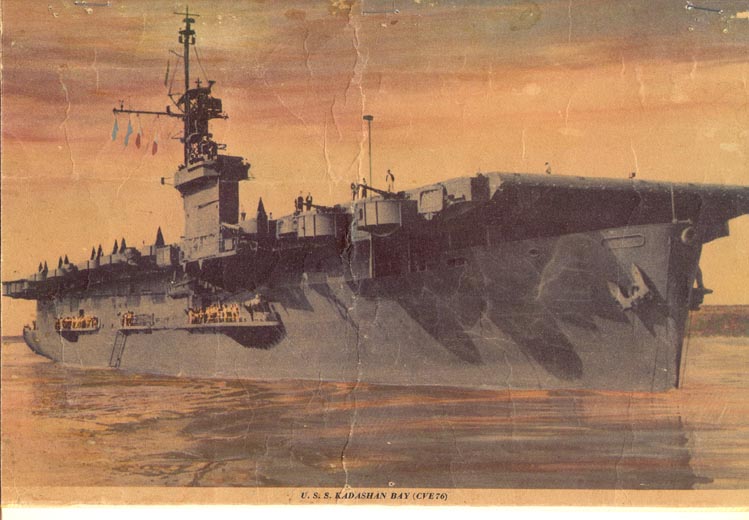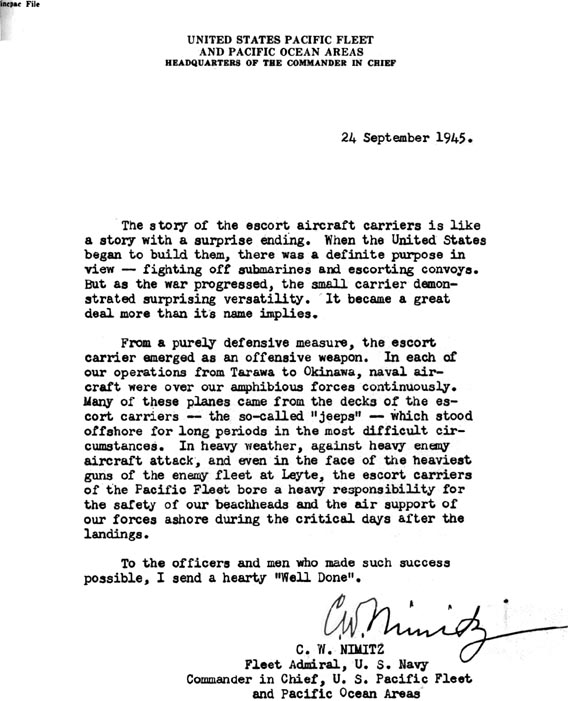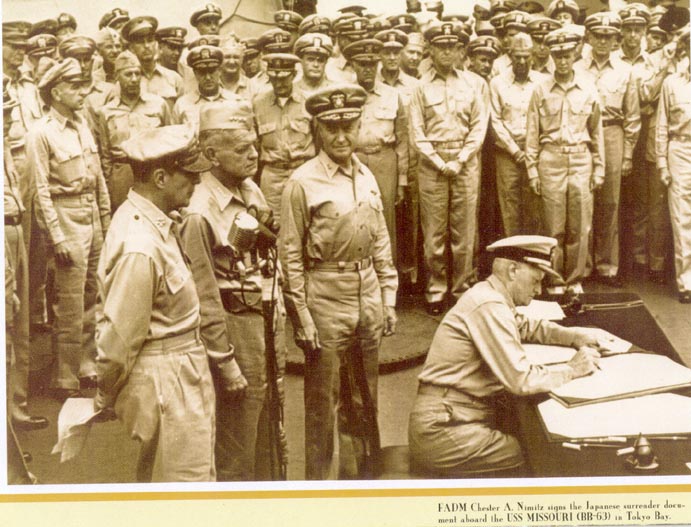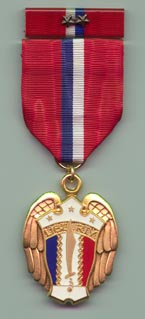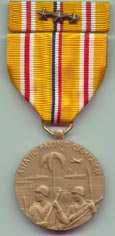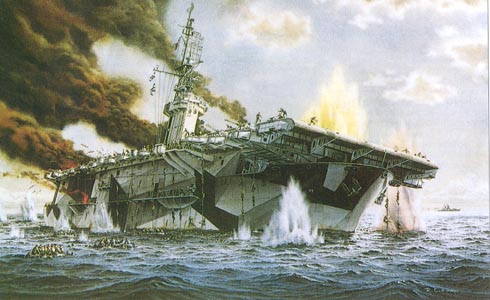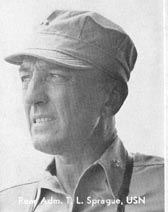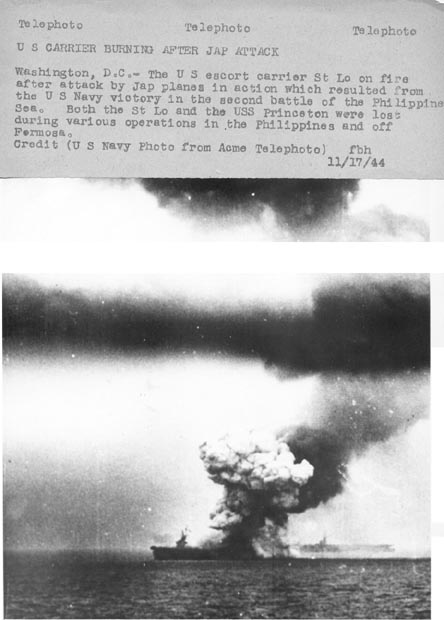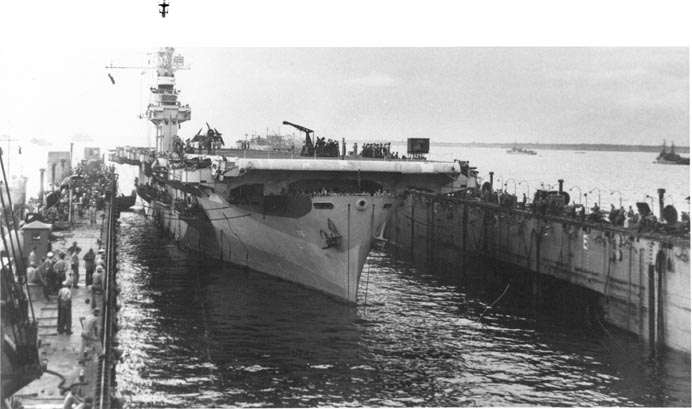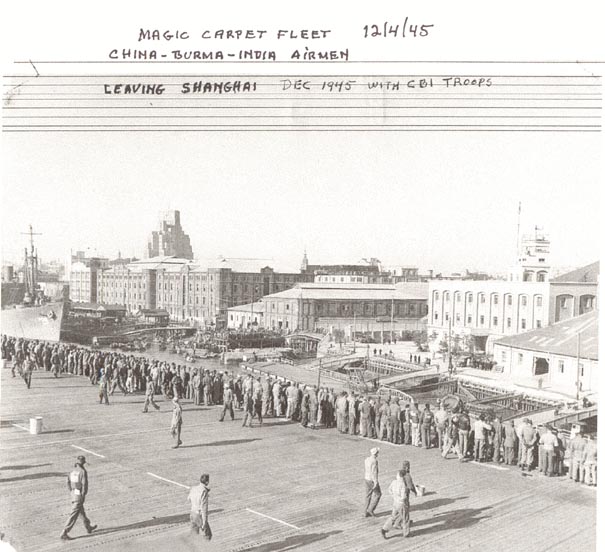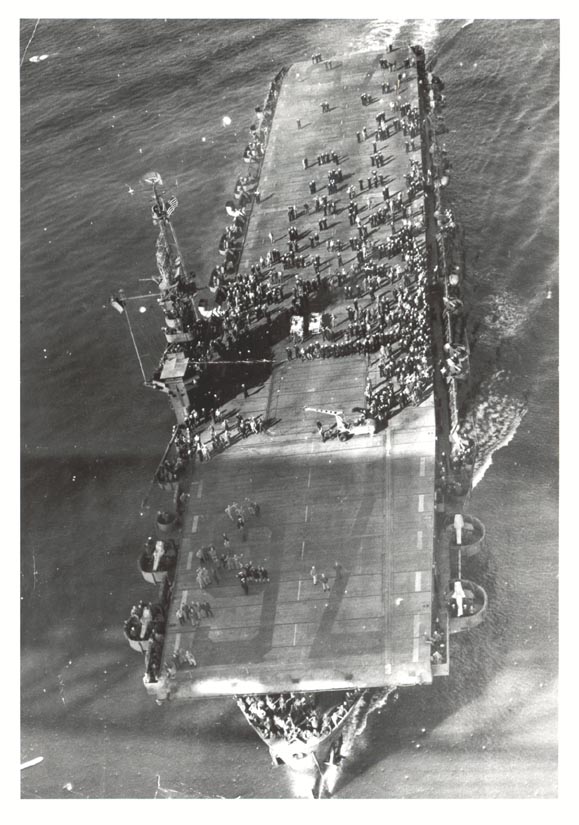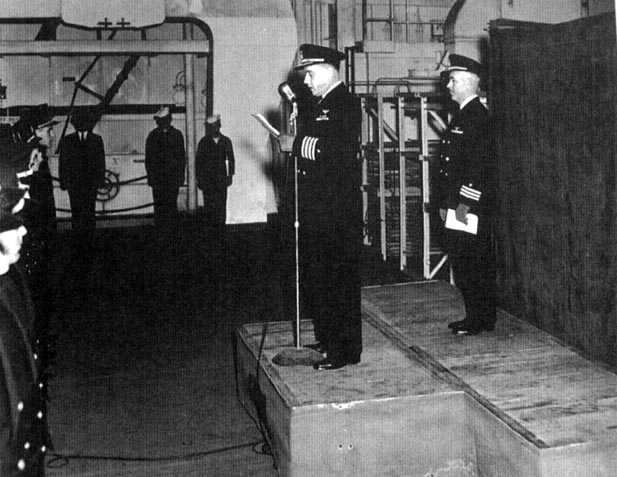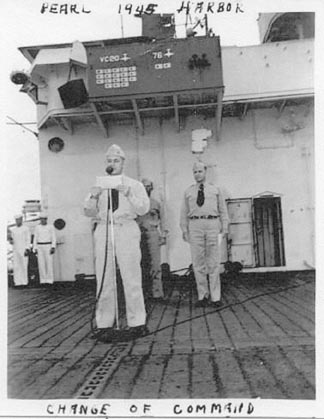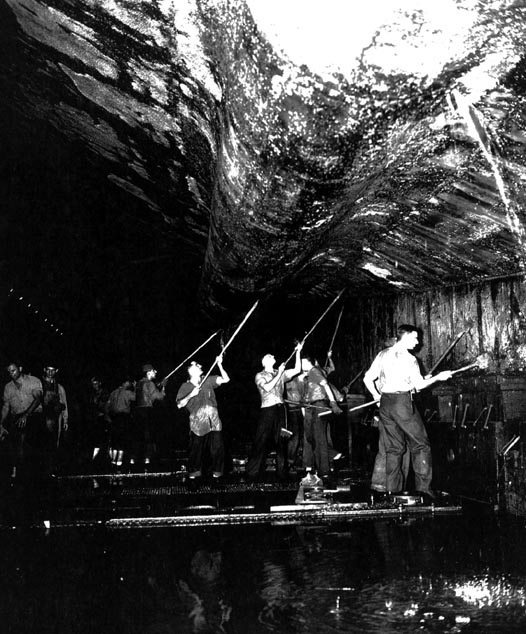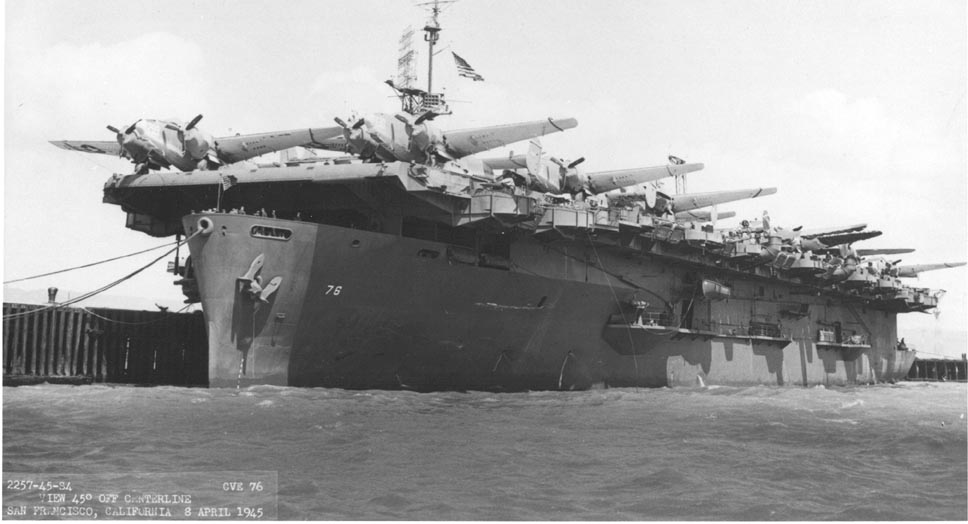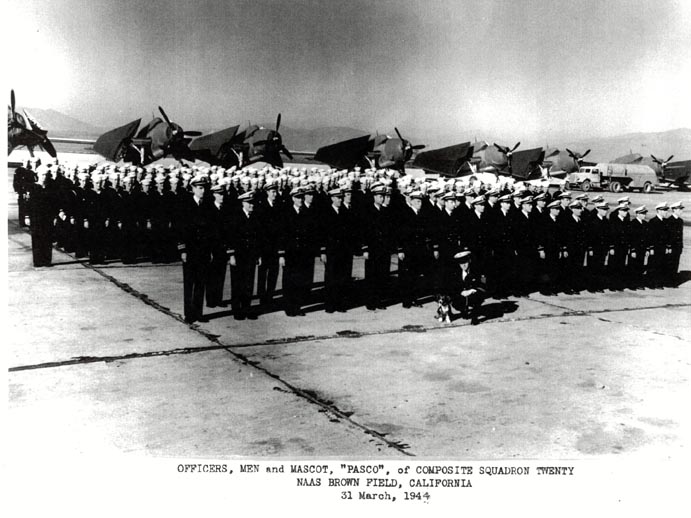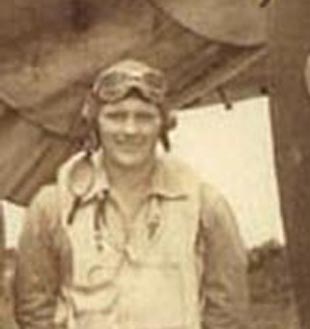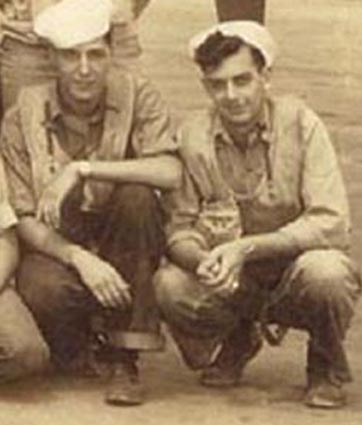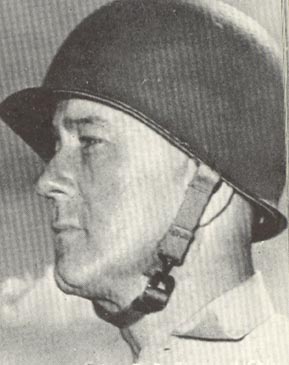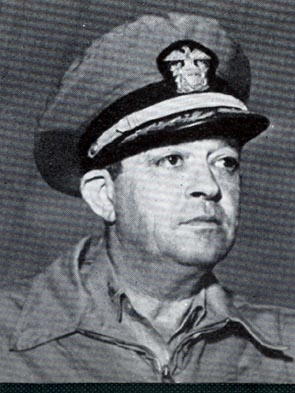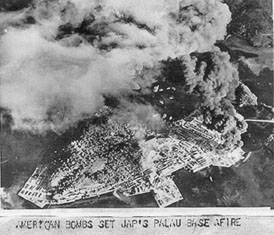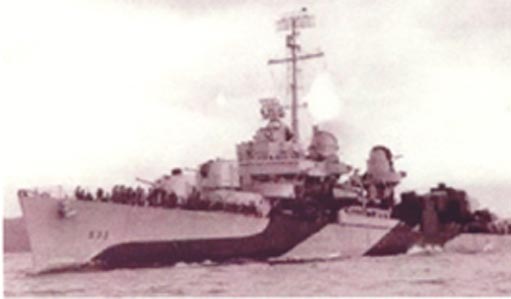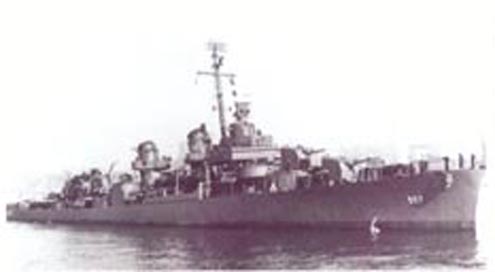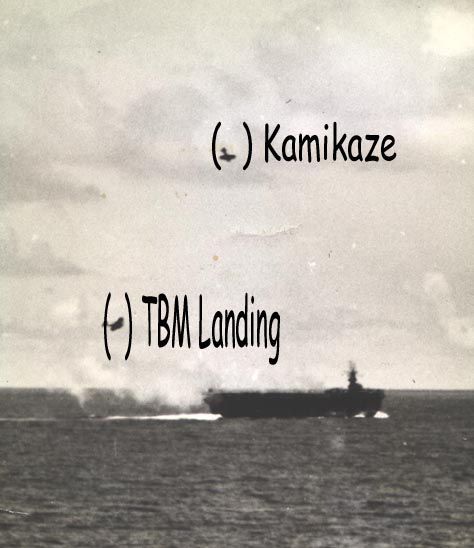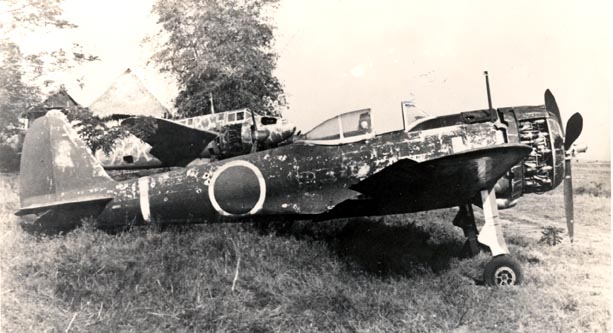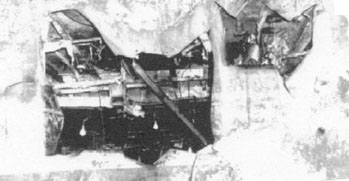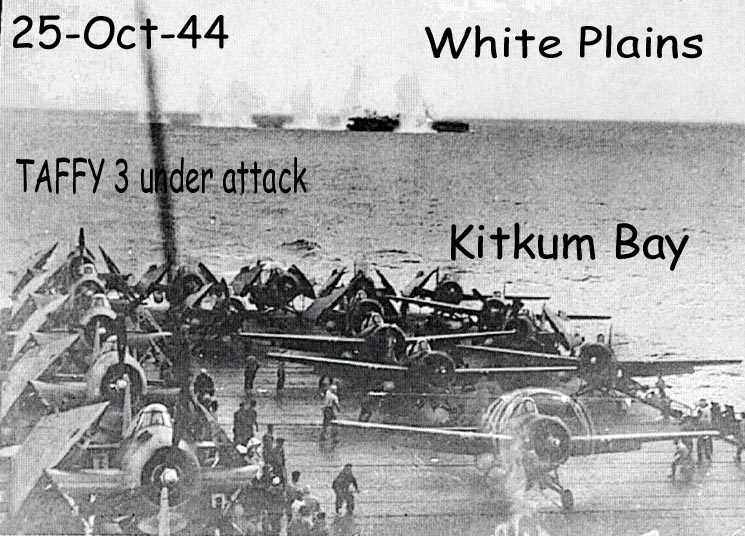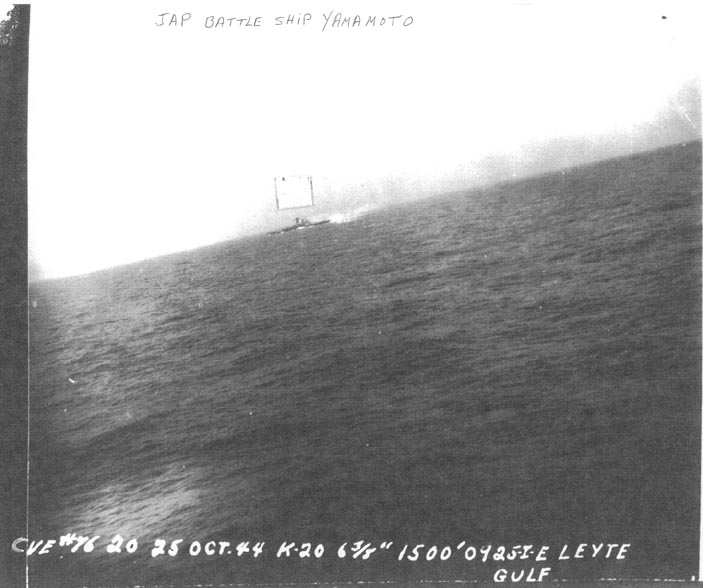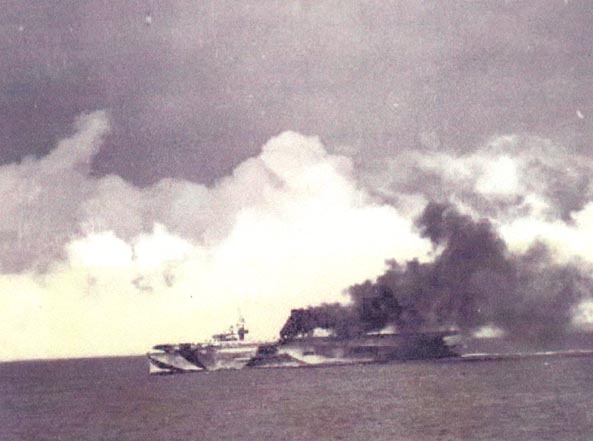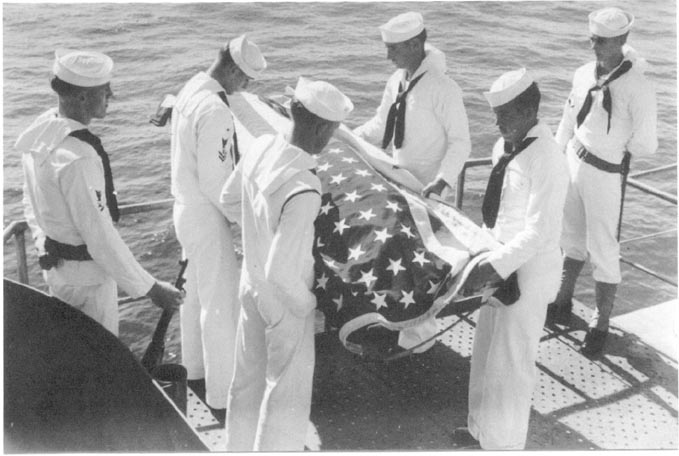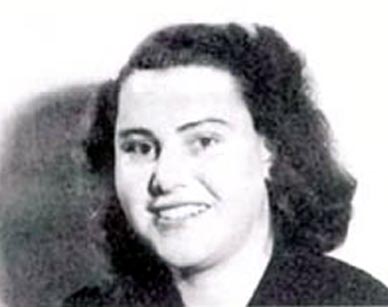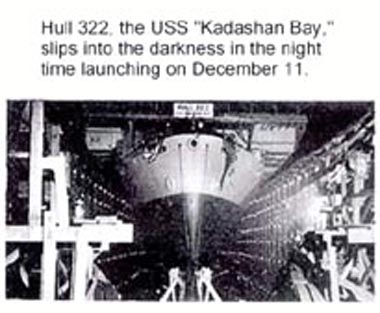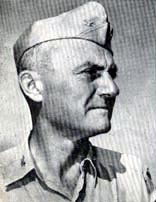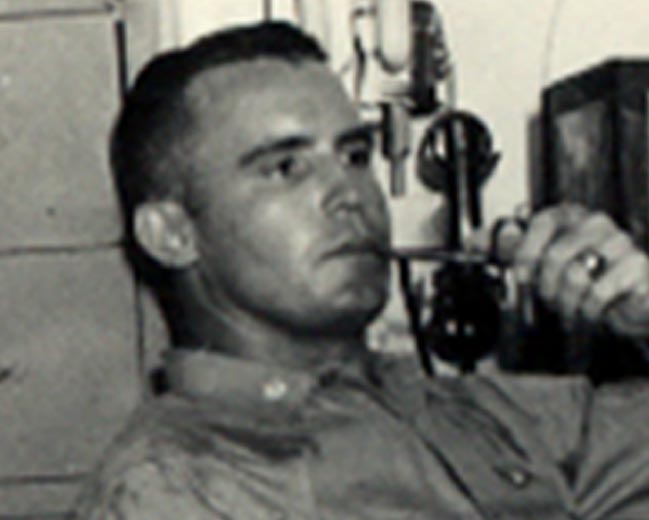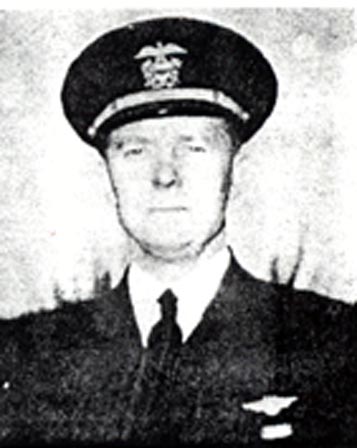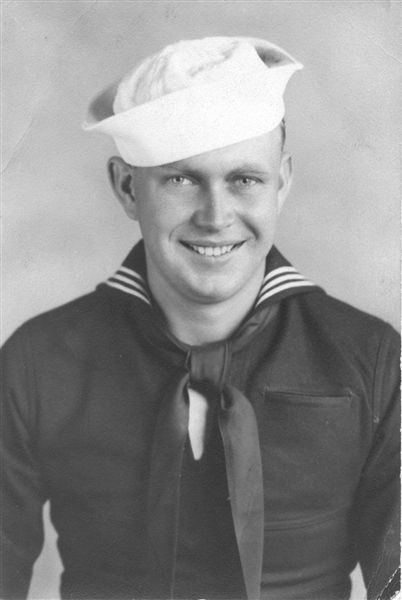History of the USS KADASHAN BAY (CVE-76)
OFFICE OF NAVAL RECORDS AND HISTORY
SHIP'S HISTORY SECTION
NAVY DEPARTMENT
ADDITIONAL INFORMATION/EDITING
BY WALTER "SKI" SKELDON
10910 DEL PRADO DR. W
LARGO, FL 33774-4644
NOTE; ITALICS ADDED TO HISTORY FOR CLARITY AND FACTS BY "SKI"
The USS Kadashan Bay (CVE-76) had a full measure of war experience in various phases
during her combat career in World War II. Built by the Kaiser Shipping Yards in Vancour,
WA, her keel was laid 2 Sept.43. Launched 11 Dec 43 shortly after midnight, she was christened by Miss Audrey Ackerman of Yakihama, WA. She had been selected by the workers at Kaiser to represent them. The Katie B was named after a Bay in Alaska.
She was fitted in Astoria, OR, where she was commissioned on 18 Jan. 44. Her first Captain was Robert N. Hunter, USN. He assumed command of the ship at the commissioning ceremony.
On 21 Feb. 44, she departed from Seattle, where she proceeded after reporting for duty with the fleet, bound for San Diego and after her shakedown cruise. After a stormy voyage, she arrived at San Diego with her green crew on 28 Feb. 44. After four days of gunnery training, The Katie B reported to Commander Fleet Air West Coast for duty ferrying aircraft.
Underway for Espiritu Santo 6 Mar. 44, CVE-76, with a load of 72 aircraft and 367 passengers, arrived at Pallikula Harbor on 22 Mar.44. After unloading by lighter, the ship set course for San Diego again carrying 44 dud aircraft. Crossing the line ceremonies was held on 3 Apr 44 with the Captain of the ship being among those initiated into Realm of Neptunus Rex. On 10 Apr. 44, she arrived in San Diego.
Four days later, she departed for Pearl Harbor with 82 planes and 457 passengers. The passengers debarked on arrival, 20 Apr. and on 27 Apr, she arrived at Majuro Atoll with USS CHANDLER as escort. She unloaded and returned to Pearl on 4 May to load dud aircraft for return to San Diego. She arrived 13 May after a voyage marked by serious engine problems.
Due to engine problems, she was granted a 21 day availability at Bethlehem Steel Yard at Terminal Island, CA. She departed 13 June for sea trials and returned to San Diego on 15 June to prepare for combat duty.
The first air squadron to come aboard was Composite Squadron 20 (VC-20) on 19 June 44. The squadron consisted of 33 officers and 38 enlisted men. The squadron was under the command of Lt. CDR John R Dale, USNR.
On 20 June she proceeded to San Clemente training area for 8 days of intense flight and deck operations training. She returned to San Diego on 29 June. VC-20 was put ashore for additional training and The Katie B spent from 2 to 7 July in the San Clemente Training area with VC-75 and VC-81 for additional flight and deck training. On 10 July, she departed for Pearl, arriving on 16 July.
In early August, The Katie B was assigned to THIRD Fleet, Carrier Division 27 (CarDiv-27), RADM. W. D. Sample, USN commanding. Other carriers of the division were, USS MARCUS ISLAND, USS OMMANEY BAY, and the USS SAVO ISLAND. On 12 Aug., the CVE's departed Pearl for Tulagi, as part of a large task force (TF), and the The Katie B assumed her combat duty by flying ASP (anti-submarine patrol). The ships arrived at Tulagi on 24 Aug. where they were joined by TF-32 in preparation for the Palau operation.
After a few days of training, The KATIE B had to return to Tulagi for engine repairs...again! While in port, and observation plane (similar to a Piper Cub) was taken aboard. On 6 Sep, the TF left Tulagi for the assault area around Palau and on 12 Sept., VC-20 commenced combat operations against the enemy including bombing and straffing and rocket attacks. There was no opposition except for the light and inaccurate AA fire. On 15 Sep, the Marines landed on Peleliu. The subsequent launching of this light observation plane from the flight deck some days later, when it took off for Peleliu Field at Palau,caused some concerns and amusement as two similar planes on other carriers had fallen into the sea on takeoff and this one barely made it, (although it had the whole flight deck for takeoff). The rest of the operation consisted of supplying air support to the ground forces.
The squadron flew 532 sorties for a total of 1765 hours. Among the known targets destroyed, was an oil barge, three small boats, one artillery position, a warehouse, five trucks, several buildings, eleven machine guns, four light and one heavy AA position silenced, two planes wrecked on the ground, one dredger and eleven boats sunk. No personnel casualties were suffered. On 2 Oct, CarDiv-27 departed Palau and arrived at Manus in the Admiralty Islands on 4 Oct 44.
She remained at Manus until 14 Oct, replenishing supplies, making minor repairs and giving shore liberty for the ships personnel. The compliment of VC-20 was increased in preparation for the Leyte operation and CarDiv-27 reported to the SEVENTH Fleet for duty, Reaching Leyte Gulf on 21 Oct, the carriers, commenced operations on the following day in support of ground forces. There were 18 CVE's present, divided into three groups across the mouth of Leyte Gulf. The KATIE B was assigned to the central group (TAFFY-2). There was no air opposition from the enemy as in the Palau operation except the planes had longer flights to their targets.
On the morning of 25 Oct, the ship was aware of a large Japenese surface force sighted the day before in Mindoro Sea, but their closest approach and the battle of Surigao Strait early in the morning was known only to senior officers. At 0551, a CAP (Combat Air Patrol) and ASP was launched and at 0630, Ens. Hans Jensen (a member of VC-20) flying a TBM1-c was alerted by his radioman, Don Lehman, that he observed a large number of unidentifed group of vessels on his radar scope, and although out of his sector, Jensen proceeded to investigate. The KATIE B was electrified to hear he had sighted four battleships accomplied by twelve cruisers and destroyers. He had correctly identified the Japanese Central Force, which had slipped through the San Bernadino Strait the night before.
Jensen spent several minutes relying his report to convince the flagship that the enemy had slipped through. He then displayed great courage by launching an unsupported attack against the leading cruiser with only depth bombs. His aircrew, Donald G Lehman, ARM3c and Kenneth M Soter, AMM3c strafed the cruiser on retirement.
Finding The KATIE B heading into the wind and rearming, he headed for Tacloban, Leyte where he obtained four 250# Army bombs. ( However, Soter had to modify the pods on the TBM as the Army and Navy did not use the same designs! The modification was mostlly using bailing wire!). With a new load, Jensen requested a target but was told to head for his ship. However, he came across two destroyers and dropped his bombs scoring at least one direct hit on the bow. Meanwhile, the ship had gone to general quarters, commenced loading torpedoes on all TBMs and with the other carriers, headed off to the South away from the enemies heavy surface guns. Reports indicated that the northern group of carriers, (Taffy-3 ), were in serious trouble from the Japanese gunfire.
At 0840, the torpedo bombers were launched from (TAFFY-2) and at the same time the screening destroyers from (TAFFY-2) were straddled by enemy fire to the consternation of all hands. An aircraft report that a "battleship is on your tail" did little to reassure the ship, but by 0910, there were no further indications of enemy ships in the vicinity.
A total of three fighter and three torpedo strikes were launched that day under conditions of great excitment and uncertainty since the battle was fought over such an extensive sea area. Planes landed on the first carrier available or proceeded to the nearest army fields ashore to rearm and refuel and hasten back into the lopsided battle. From the north, (TAFFY-3) came reports of four carriers hit and one sunk. At 0945, word came the Japanese Fleet had broken off and was retiring. However, shortly thereafter, word came that the southern group (TAFFY-1) was under a heavy suicide attacks with three carriers damaged and the USS ST LO sunk. (Note: GAMBIER BAY and ST LO were sunk from the Northern Force TAFFY-3. The GAMBIER BAY by gun fire and ST LO by a Kamikaze).
About 1200, a large number of planes from the USS HANCOCK and WASP had to land on TAFFY-2 decks after attacking the Japanese Fleet. These planes had been rushed to the fight from 300 miles to the northeast. The last plane finally landed at 1900 to end one of the wildest and most exciting days in the war career of the USS KADASHAN BAY (Samuel Elliott Morrison, Naval Historian, in his book "History of the U.S. Naval Operations in World War II" says the most damage done, planes launched and landed were by TAFFY-2, on this day).
Three aircrewman had been slighty wounded but it was days before all personnel were accounted for as many of the planes had landed on other carriers or land bases. (The last to be returned was Doy Duncan who had been shot down and spent a month on Samar hiding from the Japanese).
Addendum:
A birds eye view of the Battle of Samar.
The Battle off Samar, Philippine Islands (25 Oct 44) was so spread out it encompassed over 2000 square miles of ocean area. If it was possible to be viewed from a point high in the sky, it would look something like the following:
To the south, was TAFFY-1 (code name for TU-77.4.1) made up of the following CVE's, SANGAMON:SUWANNEE;SANTEE;and PETROF BAY. This task unit operated near the Surigao Stairt at this time in order to furnish air cover to the surface forces of the SEVENTH Fleet who defeated the Japanese forces that had tried to come through the Straits and attack American forces at Leyte Gulf, during the very early hours of the day. (During the preceding day, 24 October, the CHENANGO and SAGINAW BAY were detached to proceed to Morotai Island and return with replacement aircraft for TAFFY-1. These two CVEs would not take part in the up coming battle.).
About 100 miles to the north was TAFFY-2 (code name for TU-77.4.2) made up of the following CVE's, NATOMA BAY;MANILA BAY;MARCUS ISLAND;KADASHAN BAY; SAVO ISLAND and OMMANEY BAY, operating due east of Leyte Gulf.
Another 20-25 miles to the north was TAFFY-3 (code name for TU-77.4.3) made up of the following CVE's, FANSHAW BAY; ST. LO; WHITE PLAINS; KALININ BAY; KITKUN BAY and GAMBIER BAY.
Reveille was sounded at 0440, aboard the three Taffies. General Quarters followed at 0500, and the start of a very busy day, a historic day. Appoximately 0500, TAFFY-1 launched her search planes for the Surigao Straits and the retreating Japanese force in that area.
Approximately 0500 TAFFY-2 launched their CAP of 12 fighters for the Leyte beachead. At 0551 the local and tactical ASP/CAP was launched as per the orders of the day. MARCUS ISLAND launched a flight of ten TBMs on supply missions over Leyte, dropping emergency supplies to cut off troops. KADASHAN BAY launched her early local ASP/CAP, consisting of the customary four FM-2s and four TBMs ( one of these was being flown by Ens. Hans L Jensen).
At 0550, TAFFY-3 launches her early ASP/CAP both local and tactical. At 0600, TAFFY-3 assumed their day time disposition and the morning GQ was secured, by 0630 most of the crews are at chow.
At 0630, Ens Jensen's from TAFFY-2 is notified by his radioman, Don Lehman, ARM2c, he is picking up a large number of blips on his radar screen. Mr. Jensen, althought outside his sector/search area, decided to investigate the blips.
At 0644, Ens Jensen reports (to the KITKUN BAY, flagship of TAFFY-3) a large number of Japanese surface force approaching TAFFY-3, distance 20 miles and closing. He is ordered, by the Admiral to verify his sightings. Which he does by attacking the lead cruiser with his depth bombs ( which were designed to drop on submarines). The enemy immediately take him under AA fire ( which is spotted and reported by lookouts on TAFFY-3), at 0646.
TAFFY-3 the northern most and closest to the approaching Japanese fleet that had slipped through the San Bernardino Strait during the night and undetected until detected by VC-20's ,Ens. Jensen with his unsupported attack. Within five minutes TAFFY-3 was receiving confirmation of the sightings as the Japanese fleet began shelling the task unit.
At 0650, TAFFY-2 went to GQ and immediately started loading the remaining TBMs with torpedoes and 500 pound bombs to assist TAFFY-3 to repulse the Japanese surface unit.
Aboard the GAMBIER BAY, and other units of TAFFY-3, the radio message is intercepted about the approaching fleet of battleships, cruisers, destroyers, twenty miles distant and closing, from the northwest at twenty-six to thirty knots. Minutes later, AA gunfire was sighted and reported by TAFFY-3 lookouts, the enemy surface fleet is firing on Ens. Jensen.
The six CVEs were still in their night time circular formation, about 2000 yards ( one nautical mile) apart, with their three destroyers and four destroyer-escorts on the outer rim.
At 0658, battleships and cruisers open fire on the CVEs. Heavy salvos are seen splashing near tail-end Charlie, the escort carrier directly astern, KITKUN BAY. The CVEs went to flank speed 18.5 knots. Immediately, evasive action was taken. TAFFY-3 did manage, with the highest degree of seamanship, under the conditions at the time, to launch all their planes, as they were running close to the wind. Recovering aircraft was another story. Returning planes were directed to TAFFY-2 decks or to Tacloban if the decks were not free,where many of them did land for fuel and ammunition.
At 0702, TAFFY-1, TAFFY-2 and TAFFY-3 did recall many of their planes if not on specific missions for the Army. The planes that were aboard were rearmed with torpedoes and heavy bombs to be used against a vastly superior force. After their launch the decks of TAFFY-2 were available to any and all planes in the area and there were many who availed themselves of the service and near proximity of the battle that was raging at that time. Later in the afternoon, planes from the fast carriers used the CVE's of TAFFY-2 or Tacloban as a refueling station. Their carriers being some 300 miles distant.
Also at 0710,the USS JOHNSTON (TAFFY-3) one of the escorting destroyers (DD-557), with no orders, undertook a lone attack on the Japanese surface fleet. After expending most of her torpedoes and 200 rounds of Five inch ammuntion, she returned to the CVEs and joined other attacks moments later. She had suffered numerous large caliber shell hits.
At 0730, TAFFY-3 came out of a rain squall, into which she had entered a few minutes earlier, the enemy resumed shelling and concentrated on the GAMBIER BAY. It was noted that the Japanese did not gain on their position, they could have cut off TAFFY-3's escape route.
Meanwhile TAFFY-1, at 0730 reported three air raids converging for the next forty minutes. Some of the Japanese managed to penetrate the CAP and the infamous Kamikaze attacks had their beginnings. The first plane dove on the SANTEE, at 0740 and crashed through her flight deck, this was the first Kamikaze of the war to score a hit! The enemy plane had come out of nowhere and carrying a bomb had crashed on the port side of the flight deck and forward of the aft elevator. The plane stopped on the hanger deck which was completely engulfed in flames, and in danger of spreading to the parked aircraft, ready bombs and gasoline stored in the area.
The 2nd plane, a minute later dove on the SUWANNEE, and was immediately taken under heavy AA fire, the plane rolled over and dove on the SANGAMON. A five inch hit diverted her and she splashed close aboard. The third plane picked the SUWANNEE as her target. The kamikaze managed to penetrate the flight deck about 40 feet forward of the aft elevator, leaving a 10 foot hole in the flight deck. The bomb exploded between the flight deck and the hangar deck, blowing a 25 foot hole in the hanger deck. The explosion put the aft elevator out of operation and numerous fires were started in the area. All fires were extinguished in two hours by the repair parties and the flight deck was back in operation. The next plane singled out the PETROF BAY, approaching from the starboard bow and taken under intense AA fire. The plane splashed close aboard no damage was reported.
Just sixteen minutes after taking her Kamikaze hit, at 0756, a lurking submarine sent a torpedo into the starboard side of the SANTEE, forward between frames 58 and 60. Several compartments were flooded and the ship had a 6 degree list to starboard.
Meanwhile TAFFY-3 at 0740, ordered her destroyers to fall back and make torpedo runs on the attacking enemy surface units. At 0750, several course changes and the GAMBIER BAY and KALININ BAY are now the enemy's targets, because of their location, KALININ BAY suffers numerous heavy hits from a battleship on her starboard side about aft of the forward elevator on the hanger deck. Then it was noted there were cruisers on TAFFY-3's port side, destroyers to the starboard and battleships astern. TAFFY-3 was boxed-in. The wolves and little wolves (DDs and DEs) are ordered in for their second attack. JOHNSTON, because of slower speed, after suffering hits in her earlier attack, joins on the tailend of the DEs.
The FANSHAW BAY received her first hit,an eight inch shell from a heavy crusier. One shell passed completely through the hanger deck without exploding, just in one side and out the other. The Japanese were using armor-piercing shells on the thin skinned CVEs. A total of four, eight inch shell hits were reported with a minimum of damage.
At 0800, KADASHAN BAY and several other TAFFY-2 jeeps reported, "All available TBMs loaded with torpedoes and 500 pound bombs and ready for launching." TAFFY-2 turned into the wind and launched her second air strike at 0805. OMMANEY BAY launched four TBMs loaded with 500# bombs and escorted by seven FM-2s, several hits were scored on a heavy cruiser and the fighters strafed two destroyers.
At 0815, GAMBIER BAY suffered her first enemy hit from a heavy cruiser, an eight inch shell in her flight deck aft which left a six by eight foot hole in her flight deck. A minute later she takes her second heavy cruiser hit in the forward engine room.
At 0827, GAMBIER BAY had to secure and abandon the forward engine room, due to flooding and escaping steam from the ruptured steam lines, from the shell hit about ten minutes earlier. The ship's speed dropped to eleven knots and then she received more and more hits. Causing a heavy increase in flooding.
At 0828, GAMBIER BAY is now by-passed by the Japanese fleet, althought one heavy cruiser continues to fire point blank at the sinking ship.
AT 0833, TAFFY-2 launched another air strike comprised of 16 TBMs and 8 FM-2s to assist TAFFY-3.
At 0840, hit by a heavy cruiser in the aft engine room. All power is lost aboard the GAMBIER BAY, the only forward movement now is the ship's momentum,which soon stops.
At 0843, TAFFY-2 launches another air strike. As soon as the planes return, they are rearmed and launched again.
At 0845, the GAMBIER BAY goes dead in the water. The heavy cruiser continues to pound her at point blank range. The JOHNSTON takes on five attacking destroyers with her five inch batteriers. Her action gave the CVE more valuable time but her end is sealed.
Just prior to the later launchings (0833 and 0843), while Japanese shells were falling within the screen of protecting destroyers and destroyer-escorts, Capt Morehouse aboard the NATAMO BAY (TAFFY-2), called the pilots to the island for last minute instructions, "I don't think I have to tell you men what to do. Lay your bombs on the target or you may not have a home to come back too. Good Luck." The results demonstrated how seriously these words were taken.
About this same time, R/ADM. Sample (MARCUS ISLAND) told his pilots, "do not concentrate on sinking one or two ships, but attack and damage all ships."
At 0855, abandon ship is annoucned aboard the GAMBIER BAY.
At 0855, USS HOEL (DD-533) sank after taking over 40 large caliber hits from both five inch and eight inch shells.
At 0900, KITKUN BAY was under shell fire again and at 0907, GAMBIER BAY rolls over on her port side as the heavy cruiser continues to fire at point blank range (less than 2000 yards).
At 0911, on 25 OCT 44, GAMBIER BAY sinks.
Almost one hour after suffering her first hit. It is estimated the GAMBIER BAY suffered twenty-six large caliber hits. Later, about 750 men were rescued with their wounded, wrapped in extra life jackets. Some of the survivors were in the water for forty-five hours before being rescued.
At 0916, althought two enemy cruisers closed to 10,500 yards, all Japanese ships ceased firing, turned in circles, milled about as though confused, then they retired to the north. Reassembled and steamed away. At the time it was not known why, just that the enemy had retired.
The fifth attacking strike from TAFFY-2 is launched at 0935, consisting of 11 TBMs and 8 FM-2s. Now the tide has turned,instead of an attacking it is ia retreating Japanese force that TAFFY-2 planes attack.
At 0940, the attacking Japanese Central Force turned, breaking off engagement, milled about regrouped and left the area heading north. The planes from all three TAFFY's continued their air attacks on the now retiring fleet.
At 0940, the JOHNSTON coasted to a stop, all power lost the word was passed "abandon ship". The ship rolled over, and slid under the water at 1010. Survivors, in the water,reported seeing officers on a departing Japanese destroyer saluting the survivors.
During the ensuing battle, KALININ BAY suffered fourteen large caliber shell hits, mostly eight inch from the heavy cruisers. FANSHAW BAY suffered six eight inch shell hits, most were armor-piercing and did not explode on contact with the light plates on the jeeps. WHITE PLAINS had buckled plates from near missess.
TAFFY-3 being the closest to the Japanese surface force suffered the most damage. GAMBIER BAY has the dubious distinction of being the only American Carrier ever sunk by enemy gunfire. The other five CVEs were damaged by heavy shell fire and later that morning the ST LO was sunk during a large kamikaze attack.
TAFFY-2 was the only task unit not under attack that day. The unit was very fortunate in not being spotted by the enemy or the kamikaze units that day, but lady luck is not always on your side. The escort's of TAFFY-2 were observed to be under Japanese cruiser fire as placed themselves on the horizon, between their CVE's and the enemy vessels. The crews on the flight deck watched as salvoes splashed around the destroyers, no hits were observed, but many near missess. The escorts were soon recalled.
At 1005, USS Samuel B. Roberts. (DE-413) sinks after her attacks on the enemy units.
At 1010, USS JOHNSTON (DD-557) sank.
First the HOEL, then the ROBERTS, then the JOHNSTON went down their guns blazing to the last.
After the above described surface action, TAFFY-3 had a short respite, then she came under heavy kamikaze attacks. More damage was inflicted on the unit from the Kamikazes (Divine Wind) and their bombs.
At 1030, ST LO landed one fighter from the KALININ BAY and two TBMs from WHITE PLAINS and two of her own TBMs. These five planes were struck below, with gasoline still in their tanks, and the flight deck was cleared for any other planes to land. The other two CVEs were repairing shell damage to their flight decks so the planes were ordered to land on any available deck or proceed to Tacloban Airfield. The airfield at Tacloban was in very rough shape and difficult for heavy aircraft to take off from. A grass field which soon turned into mud.
The respite was short-lived, scarcely more than an hour and a half after the shelling had stopped, the five remaining CVEs were subjected to suicide attacks by Japanese land based planes that came in fast and headed for the carriers.
When the kamikaze first hit the St LO, at 1053, it seemed that no serious damage had been done. However, communications from the bridge to the hanger deck was gone, and the fire main pressure dropped. Three minutes later a minor explosion such as exploding gasoline, sent smoke and flames through the hole in the flight deck. The resulting fires were fueled by the gas from the recently landed aircraft and bombs. As they cooked off, the fires grew, fire mains were ruptured, hoses had to be strung from the forward parts of the ship. These hoses were holed by the next explosion as were the men in the repair party fighting the raging fires on the hanger deck. After the third violent explosion aboard the ST LO, it was apparent the ship was lost. The order was given to abandon ship at 1100.
Shortly after everyone was in the water, another explosion eight in a series of major explosions threw debris over the entire area, wounding some personnel who had escaped unscathed from previous explosions. After this explosion, the starboard list increased more rapidly to about 30 degrees, then very rapidly as material on the flight deck started sliding into the sea until the list was almost 90 degrees. USS ST LO then started to sink by the stern with a turning motion which brought all of the bow verically into the air as she sank from sight.
At 1112 on 25 Oct 44, USS ST LO (CVE-76) sinks.
During this attack, KALININ BAY was hit by two kamikazes. The first plane was a shallow glancing blow..starboard quarter port bow...the enemy plane went sliding along the flight deck and then overboard, with minimal damage to the ship. Many small fires were started on the flight deck which were easily extinguished. Right behind was another, diving at a 70 degree angle the kamikaze was hit and burning, which was believed to throw off his aim, he crashed into the aft port stack. A third plane, under the intensive AA fire missed the ship completely and crashed into the sea. The ship managed to remain in action as her damage was mimimal.
During the lull that followed, TAFFY-3 took stock of their battle damage. Four enemy surface units had been sunk and several more in different stages of damage. TAFFY-3 itself suffered two escort carrier sunk--GAMBIER BAY and ST LO; two destroyers sunk--
JOHNSTON and HOEL, one destroyer escort sunk--SAMUEL B ROBERTS. Four CVEs damaged to varying degrees--FANSHAW BAY, KALININ BAY, WHITE PLAINS and KITKUN BAY.
The FANSHAW BAY had sustained six hits from shellfire; her casualties were five dead and three seriously wounded. KALININ BAY took fourteen heavy hits and two glancing kamikaze hits in the flight deck. The flight deck was out of action but the ship was not. The KITKUN BAY suffered a glancing blow from a kamikaze, loosing a portion of her catwalk and the bomb exploded close aboard with mimimal damage to the ship. WHITE PLAINS had a few buckled plates from several near misses of large caliber gun fire and a section of her port catwalk missing after a kamikaze glancing below.
Meanwhile back at TAFFY-1, it took the repair parties, aboard the SANTEE, a little over two hours to extinguish all her fires,eliminate the list and make emergency repairs to the flight deck. In plenty of time to land her returning planes. SANTEE landed her planes at 1117, from their attacks on the Japanese Central Force and its mammouth battleship, The YAMATO with her 18.1 inch guns.
At 1200, TAFFY-1 was attacked by four kamikaze planes, in the close vicinity of PETROF BAY's stern. The 1st plane exploded in mid-air from a direct hit by one of the escorts 5 inch guns. The 2nd turned to starboard, smoking and withdrew. The 3rd plane looped into the clouds, came straight down in his dive, missed the ship and hit the water just twenty feet forward of the bridge. Exploding upon contact, drenching the ship, from bow to bridge with gasoline, oil and water. The 4th kamikaze dove straight for the flight deck and the aft elevator,when about 400 feet away from the ship, its wing and tail were shot off and it fell into the sea just aft of the fantail. A close miss, no damage to the ship. Four close calls.
Also at 1200, a large number of aircraft from the HANCOCK and WASP had to land aboard TAFFY-2 carriers after their long flight and attack on the Japanese force. The fast carriers launched their planes from over 300 miles away to assist TAFFY-3 in their defense. After the attacks,some of the planes went to Tacloban and some to TAFFY-2 for fuel and bombs. After their second attack, many returned the Tacloban and others to their own carriers or any available deck.
At 1405, two Zekes closed to twelve miles of TAFFY-1 and were shot down by the CAP. Three additional flights were launched at 1145: 1530 and 1700. Sixteen of the SANTEE crew were killed and twenty-seven wounded in the two earlier attacks.
At 1530, PETROF BAY launched six TBMs to search for and attack the retreating Japanese Fleet. Rendezvous was made with the other CVE planes, the enemy was located and attacked in the San Bernardino Strait. A cruiser of the MOGAMI class was attacked, two torpedo hits and another probable hit was claimed. All planes landed at Taclonban and remaind there for the night.
At 1840, after recovering some of their aircraft aboard the KITKUN BAY and WHITE PLAINS, the only decks that could still operate among TAFFY-3 CVEs. The ships secured from GQ after eleven hour and forty-seven minutes. The other two jeep carriers, FANSHAW BAY and KALININ BAY had sustained extensive damage to their filght decks by either heavy caliber shells or the kamikaze attacks.
Close to mid-night on the 25th of Oct 44, TAFFY-3 departed the area, being relieved of their duties at Leyte. The four CVEs headed south, without escorts for eight hours, until submarines were reported in the vicinity. Then they requested escorts which were readily furnished, their original escorts were still picking up suvivors from the ST LO.
The saving of the jeopardized Army and Marine units invading the beaches of Leyte was not without cost. The enemy lost three battleships, fiver cruisers, and possibly a sub. Our losses were two escort carriers sunk and five heavily damaged, two DDs sunk and one DE sunk. However the Japanese goal to pound our landing units at Leyte was never reached and at length Leyte was taken. The CVE's had taken a terrific hammering.
Thus did a wild day come to an end. A day that will forever be remembered by those that were there and future history buffs.
The next day, 26 Oct 44, TAFFY-1 and 2 continued attacking the retiring Japanese Forces, as did the large fast carriers.
A few minutes after noon, TAFFY-1 was again under an air attack. All four CVEs, SANGAMON, SUWANNEE, SANTEE, and PETROF BAY had launched their ASP/CAP and landed their morning ASP/CAP flights when two kamikazes planes dove in on them. The SUWANNEE had just moments before, landed a TBM who had taxied forward and was on the forward elevator when the first kamikaze struck the elevator. Both planes were destroyed with the loss of the aircrews and both pilots. The elevator was completely destroyed. Nine planes that were in the forward parking area were completely destroyed by the fire.
The second plane decided to drop his 500# bomb on the flight deck of the SUWANNEE and retire. He was splashed close aboard but not before his bomb exploded on the flight deck causing still more fires. The third plane was splashed close aboard the PETROF BAY, no damage was reported.
At dawn on the 26th, TAFFY-2 had launched six air strikes against the retreating enemy force. TAFFY-1 had probably launched the same number of air strikes, TAFFY-2 still had six operational CVEs while TAFFY-1 had only two, SANGAMON and the PETROF BAY. The SANTEE and SUWANNEE were relieved of their duties at Leyte and they retired for repairs. Meanwhile, their other two carriers, CHENANGO and SAGINAW BAY were still away on detached duty and would not return until 28 Oct.
During the afternoon of the 26th, normal operations were resumed with one strike launched against the retiring enemy force now entering the Visayan Sea. One of the carrier fighter plane was shot down but the pilot was seen being picked up by a native boat and he was returned to his ship many days later after spending an interesting time with the friendly native tribes. The remainder of the operation was routine and on 28 OCT, CVE-76 sailed for Manus in company with the other ships of the force.
During the Battle for Leyte Gulf, the air squadron of CVE-76, VC-20, claimed hits on one batttleship, two heavy cruisers, one light cruiser, and one destroyer. In addition, during the support of ground operations, two aircraft on the ground were destroyed along with damage and destruction of enemy ground installations and gun emplacements.
Arriving at Seeadler Harbor on 3 Nov, the USS KADASHAN BAY was granted 12 days of availability (floating dry dock) for work on her engines and bent propeller. Orders were received for the Mindoro operation, which involved penetration deep in the Visayen and Southern Luzon areas still under Japanese control.
On 27 Nov, KADASHAN BAY sortied from Seeadler Harbor with a task unit under RADM F. B. Stump in the carrier USS NATOMA BAY. CVE-76's air squadron, VC-20, took off from Ponam Field and returned to the KATIE B for operation. Ens. JENSEN, the young officer who had been the first to sight and correctly indentify the Japanese surface force suffered an engine failure on takeoff. He made a forced landing in shallow water but his plane flipped over trapping him and he drowned before help could arrive. It was a severe loss, keenly felt throughout the ship and squadron.
USS KADASHAN BAY arrived at Kossol Passage on 30 Nov only to learn that there would be a 10 day delay in the operation, as Japanese air opposition had not been neutralized as anticipated. Two hours after anchoring the group was underway again when enemy planes were reported approaching. The attack never developed and the ships finally returned to anchorage on 3 Dec 44.
While lying at anchor, Japanese ground forces could be seen on the northern coast of Babelthamp and offered realistic target practice during drills. Although the Japanese could clearly see the large American Force they could do little about it without air and sea power. It was a practical demonstration to all hands of the meaning of a by-passed island and what happens when a fighting force loses its air and sea power.
On the night of 12 Dec, (because of heavy casualties to TAFFY-1 and TAFFY-3 at the Battle off Samar, TAFFY-2 alone was assigned to cover Mindoro landings) KADASHAN BAY and TAFFY-2 along with other ships of the force, arrived at Leyte Gulf, entered the Surigao Strait at 0100 of the 13th and continued on into the Mindanao Sea at 0330. For the first time the ship expected strong opposition,particularly the new and frantic kamikaze suicide attacks.That afternoon the first attack developed and the squadron planes splashed two Oscars. A 3rd Oscar broke through and crashed into the destroyer HARADEN. She took a hit in the stack and down into her engine room killing many of her crew. VC-20 splashed two more Salleys, a medium bomber at 1800.
The 14th was another busy day preparatory to the landings on Mindoro on the 15th. Upon retirement on the 16th, the ships came under heavy enemy attack. The KATIE B's guns splashed a Judy dive-bomber, which was making a kamikaze run. Sailing through the Mindoro Sea and the Sulu Sea. the TU is under constant enemy observation day and night, therefore under constant air attacks from 13 to 18 Dec. On the 18th, Adm Halsey passed through the historic typhoon where the weather did more damage to the fleet than the Japanese ever did!
CVE-76 streamed through Kossol Passage on 19 Dec and anchored at Seeadler Harbor, Admiralty Islands on 23 Dec. In the action just behind them, USS KADASHAN BAY could claim eleven Japanese planes splashed with no personnel casualties.
On 26 Dec, KADASHAN BAY was assigned to the San Fabian Attack Force for the impending Luzon Operation.Departing Manus on 29 Dec, the ships of the TU rendezvoused at sea with the other units of the assault force. On 1 Jan 45, while underway refueling a destroyer escort, the DE sheered off and a line caught seaman Edgar L. Braun and carried him overboard. It was only the start of a rough year ahead for the KATIE B.
The attack force for the Luzon operation made a rendezvoused with the main force off the east coast of Mindanao in the early morning hours of 3 Jan 45. There were a few contacts from snooper planes on the 3rd but the 4th and 5th were quiet except for an unsuccessful attack by a midget sub, which was sunk. (Note: 4 Jan 45 at 1715 the OMMANEY BAY was hit by a Francis a twin engine bomber. Due to the damage inflicted by the kamikaze, CVE-79 had to be sunk by U.S.Forces). The force was off Negros Island by 6 Jan and Luzon was sighted on the 7th.
Action started early on 8 Jan. 45 with a prolonged air attack commencing at 0245. The first aircraft patrols were launched at 0700 and 0745.A third patrol was launched when a heavy air raid was detected approaching. Shortly thereafter, the lookouts reported a dogfight ahead and one plane was seen to break away. It crossed ahead of the ship from port to starboard at 8,000 yards at an attitude of 5,000 feet, then made a sharp turn and started a long fast dive headed directly for the ship's island. As soon as it came into range at 5,000 yards, the ship's starboard batteries opened fire including her 5 inch gun and scored repeated hits on the plane. In the last few seconds, the plane dropped abruptly ( a good indication the pilot was dead) but its momentum carried it into the ship's starboard side at the water line directly below the bridge.
The KATIE B listed 20 degrees to starboard and went down by the bow. Damage control parties swung into action immediately to fight fires that were threatening the gasoline tanks and to control flooding. In an hour and half, the fires were out and the flooding checked. However, the ship was drawing seven more feet of water at the bow. Part of the officer's country, storerooms and pump rooms were flooded.
It was determined the plane was a KI-43 Oscar carrying two small 250 Kilo bombs with incendiary pellets. Fortunately one did not function properly and thus lessen the fire fighting problems around the gas tanks.
Addendum:
This is a side note about the Kamikaze which struck the KATIE B. It is not part of the ship's history or Ski's editing. In May of 2001, Bob Heflin wrote the National Institute for Defense Studies in Japan. He received a reply from Capt. Nortaka Kitazawa (retired). He was trying to determine who the kamikaze pilot was, his rank, and squadron. Capt Kitazawa wrote: " 8 Jan 45, three Oscars took part in the kamikaze attack. The three pilots, all second sublieutenants were: Fumio Ochara (leader), Takao Kawano, and Masanao Yamamoto. They were members of the Rikugu-Tokko Hatsko Di Kyu Tai, Itssei Tai team. One of the three pilots succeeded in making the attack". He noted the planes took off from Del Carmen south of Clark field and all three were classmates of the first special short educational course on new pilots. The dogfight seen shortly before the attack, took out the other two planes. It should be noted the kamikaze that struck the KITKUN BAY on 8 Jan, took off from Clark Field at 0300. Source: THE DIVINE WIND by Capt. Rikihei Inoguchi,Cdr Tadashi Nakajima and Roger Piniaus. Appendix A, page 220.
The only personnel casualties were three slightly wounded and one officer missing. He was a squadron pilot, Lt. A.F. Buddington. He had been in the officer's country and apparently was knocked unconscious. When he came to, he was floating in the sea astern of the ship and without any floation gear. He had apparently floated out through the (9x17) hole in the ship's side. He was spotted and picked by PC-1600 suffering from internal injuries from which he recovered.
The KATIE B could still conduct operations but she handled sluggishly and heeled alarmingly in turns due to the free surface and tons of sloshing water in the flooed areas. A few planes were launched and landed during the day but most had been transferred to other carriers by the end of the day.
By 9 Jan, repairs were completed to the gasoline pump room and weight shifting was continued to correct the trim of the ship. On the morning of the 10th, the ship flew CAP before transferring her remaining planes and personnel to other carriers, (keeping four FM-2s and two TBMs for air cover, if needed over the group of damaged ships). CVE-76 joined the convoy and departed. Arriving Leyte on 12 Jan. At Leyte, the ship went along side the USS CULEBBRA ISLAND (ARG-7) to install a temporary patch over the 9x17 hole in her starboard side. This allowed her to pump out the water and to assure a safe passage back to the U. S.
By 18 Jan, she was ready to depart Leyte for Seeadler Harbor where she arrived 23 Jan Aviation stores and gasoline were unloaded here and dud aircraft were taken aboard for eastward voyage.
On 27 Jan, the ship's executive officer, CDR Robert E. Goodgame, Jr. and the ship's medical officer, CDR M. V. Kappius, disappeared on a routine familiarization flight in a Dauntless Dive Bomber (SBD). No enemy activity was reported in the area and no trace was ever found of the men.
The KATIE B departed Manus on 29 Jan, arriving at Pearl on 6 Feb 45. Upon arrival, Capt. Jack P. Monroe,USN assumed command of CVE-76 from her first commanding officer, Capt. Robert N. Hunter. He had been selected as a staff member for the NAVAL COLLEGE.
Underway for the United States the next day, CVE-76 steamed under the GOLDEN GATE on 13 Feb 45. Here CVE-76 said farewell to her squadron, VC-20 after seven months and five campaigns together.
On 16 Feb, CVE-76 moved into the yards of United Engineering Company at Alameda, CA for a 47 day availabilty and much needed leave for all hands. Repairs were completed and the ship left the yard on 31 Mar 1945. Post repairs trials were completed on 7 Apr, when aircraft and passengers were taken aboard for departure the next day to Pearl Harbor.
Upon arrival at Pear on 14 Apr, CVE-76 reported to Commander Transport Squadron, Pacific Fleet (ComTranRonPac), for duty. The next few months were spent routinely ferrying new aircraft and passengers to Pearl, Guam, Manus and returning passengers and dud aircraft back to the States.
A 17 day availability was granted at the Naval Repair Base, San Diego on 2 Jul. Upon completion of repairs,KADASHAN BAY was ordered to report to Logistics Support Group of the Third Fleet for duty as a replenishment carrier. Following a brief period of refresher air operations,combat ready planes were loaded and departure for Pearl was made on 22 Jul, KATIE B continued steaming westward for Eniwetok on 10 Aug in company with the carrrier SITKOH BAY. Tactical and gunnery exercises were conducted en-route.
Due to crossing the International Date Line 14 Aug, the Shellback initiation was skipped when news of the Japanese surrender reached the ships on 15 Aug. A VJ day celebration was held onboard and on 18 Aug, CVE-76 anchored in Eniwetok Harbor. With the war over, the ship awaited new orders at Eniwetok with swimming and fishing providing the recreation for all.
Departing from Eniwetok on 6 Sep, the KATIE B arrived at Guam on 9 Sep to learn that she was to be assigned to the "MAGIC CARPET" fleet,returning veterans to the States. Aircraft were unloaded and 49 officers and 600 enlisted personnel were embarked for the return voyage. Additional passengers were embarked at Pearl Harbor before the ship continued eastward to arrive at San Francisco on 26 Sep 45.
Additional bunks were installed at the Richmond Shipyards for carrying passengers and during October 1945, CVE-76 made two voyages to Pearl to return Navy and Marine personnel. On 30 Oct, the ship entered Mare Island Navy Yard for a 10 day availability.
Underway again on 10 Nov, CVE-76 steamed to Guam and Oknawa where she arrived on 28 Nov after dodging a typhoon. From Okinawa, the ship diverted to Shanghai, China, arriving on 1 Dec. Here she took onboard 1200 troops from the 10th and 14th Army Air Force and departed 4 Dec for return to the States via Pearl. CVE-76 pulled into San Pedro, CA. on 22 Dec 45.
At this time, The KATIE B received orders to report to Commander Boston Group,Atlantic Reserve Fleet for inactivation. On 5 Jan 46, USS KADASHAN BAY moved to San Diego and the 10th, cleared port for the Panama Canal and onto Boston arriving on 29 Jan 46. The ship was given a pre-inactivation overhaul, and 8 Feb 46, Capt Monroe was relieved as the commanding officer by the XO,CDR H.K. Edwards,USN. In May 1946, the USS KADASHAN BAY, CVE-76 was placed out of commission in reserve as part of the Boston Group, U.S. Atlantic Fleet. (there she remained until sold for scrap in 1959!)
